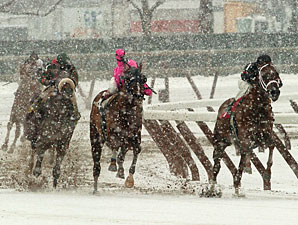Winter Racing Focus of New York Hearing

It was billed as a legislative hearing to take testimony on ideas for the future governing structure of the New York Racing Association, but those taking the New York Assembly Racing Committee up an offer to speak Nov. 18 had little to say about the topic.
Instead, a couple of state lawmakers, including Assembly Racing and Wagering Committee chairman Gary Pretlow, heard views from breeders and horsemen about the importance of continuing winter Thoroughbred racing and comments from an array of animal welfare advocates about equine safety issues.
No one from NYRA testified.
With the state likely sometime in the spring of 2015 to decide on the future of NYRA, lawmakers are starting to gather information about possibilities for the corporate structure of NYRA once a three-year state oversight period ends in less than a year.
Days after telling The Blood-Horse he believes some form of heightened oversight by the state will likely be needed after the three-year NYRA Reorganization Board expires next October, Pretlow noted during the Nov. 18 hearing that barely any of the groups signed up to testify before his panel would be speaking on topic.
Eight of the nine people testifying at the hearing came to talk about equine health and safety issues, with representatives of animal-rights organizations urging everything from better regulation of the industry to having outside police agencies enforce animal rights laws at NYRA tracks.
In offering joint testimony and responses, Jeffrey Cannizzo, executive director of the New York Thoroughbred Breeders, and Rick Violette Jr., president of the New York Thoroughbred Horsemen’s Association, used the hearing to express concerns that NYRA will at some point shut down Aqueduct Racetrack and put an end to winter racing.
Cannizzo called those racing at Aqueduct “the true New Yorkers” who live and work in the state, unlike the Saratoga Race Course meet, and said 47% of NYRA’s New York-bred races occur at the
Violette said if Aqueduct is closed—and the land sold off by the state, which owns the property—then the state must commit to a major rehabilitation of
Though he didn't advocate Aqueduct's closure, Violette said if that happens, the state should use a portion of any real estate sale proceeds to a
Violette said there are talks to reduce the number of racing dates at Aqueduct near the end of the winter meet when field size gets to be an increasing concern. But, he said: “We have to make sure that we don’t enter into a very slippery slope where small breaks in racing become significant breaks."
Violette was the one person testifying who offered Pretlow a bit of what the hearing was called to address: NYRA’s future governance. Violette said the next configuration of a NYRA board should have voting members representing both the breeders' organization and horsemen’s group, and he said NYRA needs to remain as a not-for-profit that is not beholden to outside stockholders.
The others testifying spent their allotted minutes pushing Pretlow to use the upcoming talks over NYRA’s future to enact tougher equine medication laws with stronger sanctions for violators, bans on shipment of horses in the state headed to overseas slaughterhouses, and to bring in outside law enforcement to monitor unsafe conditions for horses.
“NYRA should be setting an example for the rest of racing," said Dr. Lester Friedlander, head of Citizens Against Equine Slaughter and a former New York regulatory veterinarian. He, and others, called for stronger oversight of the industry by state regulators.
